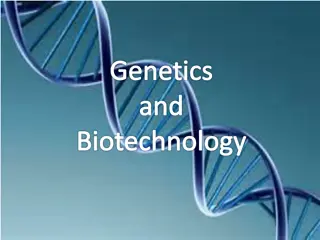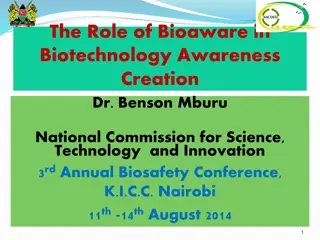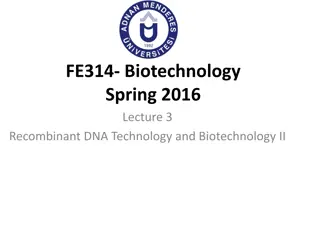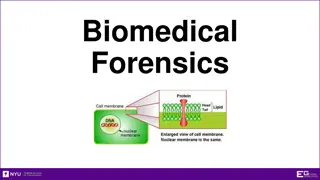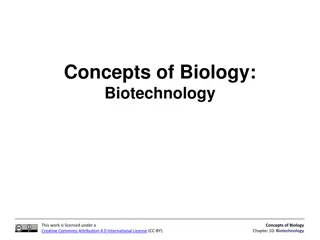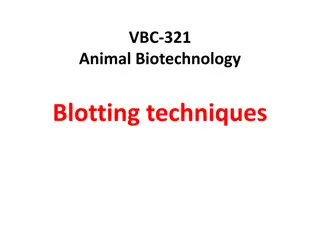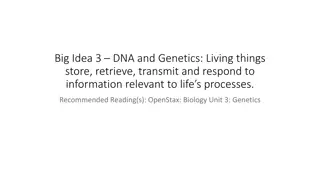Understanding DNA Probes and Fingerprinting in Animal Biotechnology
DNA probes play a crucial role in DNA fingerprinting, aiding in the detection of specific genetic sequences. Different types of probes, such as oligonucleotide, DNA, and cRNA probes, are utilized for various applications. Labeling methods, advantages, and disadvantages of hot and cold probes are discussed in detail, highlighting the importance of probe generation techniques in biotechnology.
Download Presentation

Please find below an Image/Link to download the presentation.
The content on the website is provided AS IS for your information and personal use only. It may not be sold, licensed, or shared on other websites without obtaining consent from the author. Download presentation by click this link. If you encounter any issues during the download, it is possible that the publisher has removed the file from their server.
E N D
Presentation Transcript
VBC-321 Animal Biotechnology DNA PROBES AND DNA FINGERPRINTING
A probe is a nucleic acid which has been labeled i.e., chemically modified in some way which allows it and hence anything it hybridizes to, to be detected. There are three major types of probe: Oligonucleotide probes, DNA probes and cRNA probes (riboprobes) Oligonucleotide probes are synthesized chemically and end labeled DNA probes which are cloned DNAs or PCR products and may either be end-labeled or internally labeled during in vitro replication
cRNA probes (complementary RNA probes) or riboprobes which are internally labeled during in vitro transcription of cloned DNA. Riboprobes and oligonucleotide probes are generally labeled as single-stranded molecules. DNA may be labeled as a double-stranded or single-stranded molecule, but it is only useful as a probe when single stranded and must be denatured before use.
PROBE LABELING Probes of the highest specific activity are generated by internal labeling, where many labeled nucleotides are incorporated during DNA or RNA synthesis. End labeling involves either adding labeled nucleotides to the 3 end of a DNA strand or exchanging the 5 phosphate group for a labeled moiety.
DIFFERENT WAYS OF GENERATING PROBES Labeling method Probe 5 end labeling Oligo / DNA Replacement of 5 phosphate group with labeled (gamma) g -phosphate group of free nucleotide catalyzed by T4 polynucleotide kinase 3 end labeling Oligo / DNA Tailing with labeled nucleotides using terminal transferase Nick translation DNA Nicks introduced into dsDNA by Dnase I and free 3 ends extended by DNA polymerase I using labeled nucleotides Random priming DNA Short random primers annealed to denatured DNA and extended by DNA polymerase using labeled nucleotides. Higher specific activity probes than nick translation Primer extension DNA As above but using a specific primer. Used to label PCR products during thermal cycling In vitro transcription RNA Single strand RNA produced by in vitro transcription using labeled nucleotide
ADVANTAGES AND DISADVANTAGES OF HOT AND COLD PROBES Hot probes Advantages More sensitive in the shortest time. More specific in nature. Disadvantages Short half-life. Expensive. Inconvenience of disposal. Hazards of working with the isotopes are more. Carcinogenic. Requires sophisticated laboratory facilities.
Cold probes Though they are not so sensitive as hot probes, the disadvantages of the hot probes can be avoided. Generally probes range in length from 100 to more than 1000bp, although both larger and smaller probes can be used. Depending on the conditions of the hybridization reaction, stable binding requires a greater than 80% match within a segment of 50 bases.
APPLICATION OF DNA PROBES For genetic engineering research. For identification of specific plasmids and antibiotic resistant genes from clinical isolates. For diagnosis of infectious diseases. For identification of food contaminants. For forensic investigations. For epidemiological studies. For distinguishing organisms at species and strain level. Ante-natal diagnosis of inherited diseases.
DNA finger printing (DNA profiling, DNA testing) is a process which uses fragments of DNA to identify the unique genetic makeup of an individual Before the invention of PCR, the only method of establishing and authenticating personal identification was by the DNAfingerprint process Since no two individuals have been found to have identical pattern of ridges on their fingers, this method has been universally accepted as a means of personal identification In 1984, Sir Alec Jeffreys at the University of Leicester in England was able to distinguish differences among individuals based solely on their DNAcomposition
METHODS OF DNA FINGER PRINTING The main types of DNA fingerprinting methods in use are: Restriction fragment length polymorphism (RFLP) Polymerase chain reaction (PCR) Amplified fragment length polymorphism (AFLP) Short tandem repeats (STR)
RESTRICTION FRAGMENT LENGTH POLYMORPHISM (RFLP) Restriction fragment length polymorphism (RFLP) analyzes the length of the strands of the DNA molecules with repeating base pair patterns While about 5% of DNA contains the genes, the other 95% is considered as non-coding genes (junk DNA) but contains identifiable repetitive sequences of base pairs, which are called Variable Number Tandem Repeats (VNTR) To extract a DNA fingerprint, a Southern blot is performed and the DNAis analyzed via a radioactive probe The restriction fragment length polymorphism analysis is used to detect the repeated sequences by determining a specific pattern to the VNTR, which becomes the person's DNAfingerprint The drawback with this system is that it requires a considerable amount of DNAin order to be used
Restriction Fragment Length Polymorphism (RFLP) Nucleotide sequence variations in a region of DNA that generates fragment length differences according to the presence or absence of restriction enzyme recognition sites.
RFLP The RFLP fragments can be separated by gel electrophoresis.
RFLP RFLP animation
VNTR Variable Number Tandem Repeat (VNTR) sequences that are repeated multiple times and the number of repeats varies from person to person.
VNTR VNTRs usually occur in introns VNTRs can be amplified by PCR and run on agarose gels to produce unique DNA fingerprints
PCR The PCR analysis amplifies the DNA molecules using a smaller sample On the forensic front, the PCR found to be useful in identifying DNA fingerprints in criminal matters and in paternity tests because it requires less amounts of DNA as it makes identical copies of the DNA sample The PCR analysis amplified isolated regions on the strands of the DNA under examination. The drawback is that it can not as discriminating as the RFLP
AMPLIFIED FRAGMENT LENGTH POLYMORPHISM Amplified fragment length polymorphism (AmpFLP) is a popular DNA finger printing technique It remains attractive because of its relatively less complicated operation and the cost-effectiveness of the procedure By using the PCR analysis to amplify the minisatellite loci of the human cell, this method proved quicker in recovery than the RFLP However, due to the use of gel in its analysis phase, there are issues of bunching of the VTRN's, causing misidentifications in the process
SHORT TANDEM REPEATS The short tandem repeat (STR) methodology for extracting DNA is the system most widely used form of DNA fingerprinting This system is based on the features of PCR, as it utilizes specific areas that have short sequential repeat DNA The STR analyzes how many times base pairs repeat themselves on a particular location on a strand of DNA The big advantage in this method is that the DNA comparisons can match the possibilities into an almost endless range DNA fingerprinting has been extremely successful for use in the personal identification of criminal suspects, paternity issues, as well as in identification of the deceased DNA, however, still poses issues because the VNTRs are not evenly distributed in all people because they are inherited However, as forensic science continues its work in DNA testing, there appears to be no limit to the value it can render to society
Applications Diagnosing Disease
Applications Forensics



